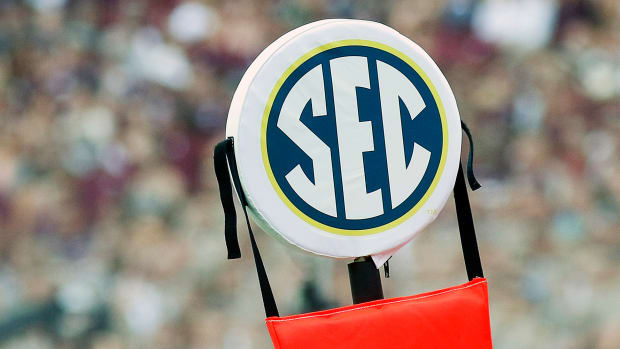The conference will kick off three weeks later than the scheduled Labor Day weekend start.
The SEC is going at it alone.
Presidents from the nation’s premier college football conference adopted a plan to play a 10-game, conference-only schedule this fall, sources told Sports Illustrated on Thursday.
The league will kick off the season Sept. 26, three weeks later than the scheduled Labor Day weekend start. While the SEC’s divisional structure is expected to remain the same—winners of two seven-team divisions playing in a Dec. 19 championship game—league teams will play two more opponents from their opposite division. A normal SEC schedule includes eight conference games—six against inner-division teams, one against a permanent team from the opposite division and one against a rotating team from the opposite division.
The decision Thursday was not a surprise. SI reported the potential plan in a story Wednesday. However, many believed the ACC’s announcement Wednesday regarding its scheduling model could impact the SEC’s plan to move to a conference-only schedule. The ACC announced an 11-game schedule with 10 conference games and an option for one non-conference game that must be played in that ACC team’s home state. It left the door open for four traditional SEC-ACC rivalry games, including Georgia-Georgia Tech, Florida-Florida State, Kentucky-Louisville and South Carolina-Clemson.

The SEC’s decision, however, eliminates those contests, along with several other non-conference games against Power 5 teams: Tennessee-Oklahoma, LSU-Texas, Mississippi State-NC State, Baylor-Ole Miss, Arkansas-Notre Dame and Vanderbilt-Kansas State. The SEC had already lost two Power 5 games with the Pac-12’s decision to hold a conference-only season: Texas A&M-Colorado and Alabama-USC. The league lost two more when the ACC announced its decision Wednesday: Georgia-Virginia and Auburn-North Carolina.
The Big Ten was the first major conference to announce a league-only schedule. The Big Ten and Pac-12 are expected to soon reveal their 2020 slates. Leagues are shifting to conference-only models for an assortment of reasons. They allow for flexibility to potentially move games postponed because of virus outbreaks and free up leagues to delay a start to the season. Also, they can all operate under a uniform, conference-wide testing protocol.
Conference-only schedules as well provide television partners with juicy marquee conference collisions on a weekly basis, and a conference-only slate may even save the SEC millions of dollars.
A conference-only model eliminates games against Group of Five and FCS teams. These are often referred to as “buy games” because SEC teams pay steep prices—sometimes as much as $1.5 million a game—to their traveling competitors. In fact, SEC teams in 2017 paid out more than $45 million in buy games, according to school NCAA reports obtained by SI. SEC teams could owe millions to those smaller clubs for cancellations. However, there is a potential out. In at least some game contracts, a change in “league scheduling format” could free an SEC team from its contractual responsibility, several administrators told SI.
The SEC’s decision doesn’t mean a season is imminent. Virus case numbers, on the rise over the last month nationally, are still high, with many hotspots in the SEC’s 11-state footprint. The decision from the SEC and other Power 5 leagues hinges not only on the decline of overall case numbers but also the success of professional sports teams, many of which are experiencing problems as they return to practice. The hurdles to playing a season amidst a pandemic are a plenty: testing availability and delays in testing turnaround time; the return of thousands of students onto a college campus; a mandatory 14-day quarantine for positive contacts; and maybe most of all, the lack of a college sports bubble like the NBA has created.
Some of the obstacles are about optics. College administrators fear the look of using thousands of tests on college football players only for them to then collide against one another on a field and be tested again week after week. Some local health departments and testing labs are growing overwhelmed because of the amount of cases, too.